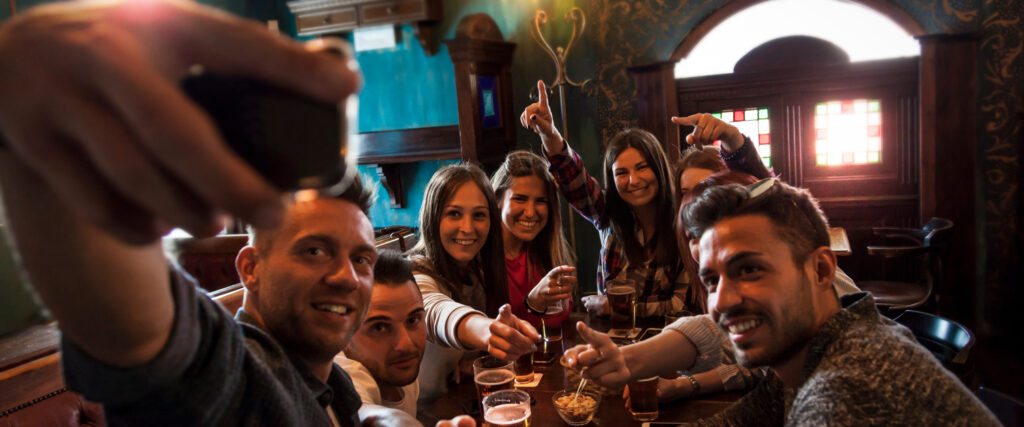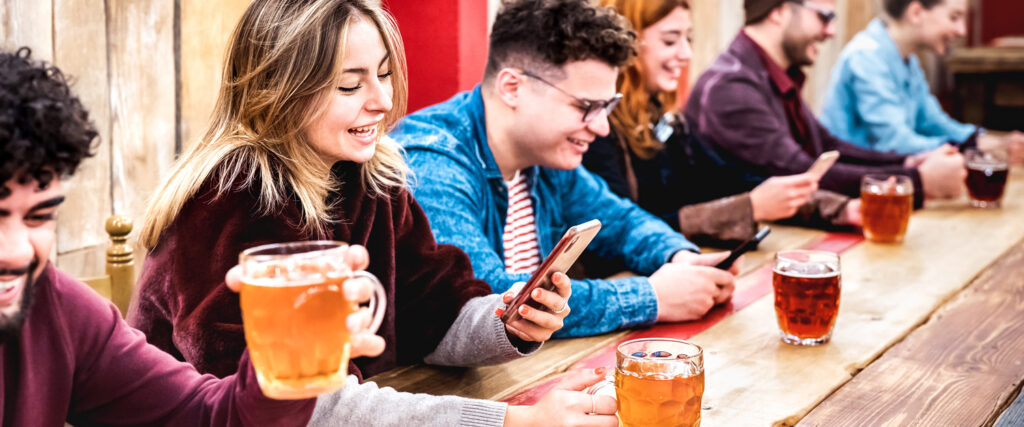On Instagram, beer influencer Jason Hackett is paying a visit to The Archouse in Bermondsey, the de facto taproom of South London’s Anspach and Hobday brewery. Better known by his nom de plume, ‘The Prime Mutton’ Hackett visits from his home in Manchester regularly, typically when his beloved Manchester City FC are playing one of its London Premier League rivals. His drink? London Black, a nitro porter that today makes up more than two-thirds of Anspach and Hobday’s total production.

“That’s an absolute creamer,” Hackett says, reeling off what has become his signature catchphrase in a self-shot piece to camera. “This is the best independently produced stout or porter in the United Kingdom.”
Wearing a thick moustache and clad in suspenders and a pork pie hat, there’s an endearing charm to Hacketts approach to beer communication. It’s not dressed up in lingo and is rooted in sincerity and a deep love for pints – especially his beloved Guinness. It was a review of the bestselling Irish stout in Dublin’s John Kavanaghs (also known as The Gravediggers) that first catapulted him into the limelight. Describing his pint as “mother’s milk” Hackett quickly became a treasured resource for information on where to get the best pints of The Black Stuff. In turn, he has also generated a fandom which he affectionately refers to as his “Muttonistas”. As of February 2025 he now has a staggering 144,000 followers.
To put that in perspective, decorated author and four-time Beer Writer of the Year winner Pete Brown has slightly less than 5500 on the same platform. That’s not a number to be sniffed at, but it demonstrates why Hackett’s impact is not to be dismissed half-heartedly. When he arrives to film at a venue, his fans will be waiting for him there. When he veers away from Guinness and tells his fans to drink London Black, they do. In fact I can anecdotally inform you that when they arrive in search of it at one of his locals, Reasons to be Cheerful in South Manchester, they will leave without selecting something else in its stead if it’s not available. Underestimate the influence of personalities like Hackett, and the hundreds, or possibly even the thousands of others attempting to do the same, mostly via Instagram or TikTok, at your peril.
Beer is the most consumed alcoholic beverage in the UK, and is almost certainly the most talked about. Yet it does not receive the same level of coverage as, say, wine or restaurants in the national media. This is because wine and restaurants are perceived en-masse as being aspirational, and historically the working class roots of beer-drinking is not. And yet there remains a large portion of the British public who are interested in beer on both a cultural and an intellectual level. This is why we have beer writing; born out of necessity for those who wish to engage with beer in a deeper and more meaningful way.
For the past few years beer and pubs where it is traditionally consumed has been at something of a cultural crossroads. Long gone is the boom-era of the 2010s when breweries were opening left, right and centre. Today about a third of younger adults don’t drink alcohol at all, and ‘mindful’ or ‘wellness’ cultures now fulfil the role that beer did in the past. For many of these individuals the gym has become to them what the pub might have been for previous generations.

Another shift is the increasing price of beer, especially that from younger, more aspirational independent breweries. Good beer is not cheap. This means that, like wine or restaurants, beer now has the opportunity to market itself as a premium product that people are interested in making a core part of their personalities. We’ve certainly witnessed this in craft beer over the past decade, as Millennial-era early adopters who helped drive the aforementioned brewery boom, as said breweries took these enthusiastic customers and turned them into fans.
As this generation moves into a life-stage that is more centred around having families, raising kids, and saving up for a week in Provence, it leaves the stage clear for Gen Z-drinkers who are taking beer-as-a-personality-choice into their, much more mainstream domain. It is from this that modern beer influencer culture draws its strength. Guinness fits perfectly into its pint-shaped hole too – it’s (perceived as being) a little bit different, it’s not cheap (although trying to find the best-value pints is a niche within this trend), and it’s had millions of pounds worth of marketing poured into it to ensure its absolute dominance.
Beneath this fandom is another cultural movement that feeds into what this generation is drinking. More often than not when it comes to taking photos of creamy pints of G, they’re looking to do so in rough and tumble, carpet-and-fruit-machine boozers. Step in Jimmy McIntosh another ‘influencer’ (who also happens to be an excellent writer) who through his satirical Instagram account London Dead Pubs not only documents the plight of many beleaguered boozers in the capital, but also celebrates the hum-drum boozers, the run-of-the-mill pubs, and the incredibly endearing locals.
More recently, between writing sharp, witty pieces about drinking culture for The Fence and Vittles he’s also produced (admittedly very good) adverts on Instagram for Stella Artois. This demonstrates that beer influencer culture in the UK has become far more impactful than traditional avenues of beer writing, and is now being enthusiastically discussed in the marketing board rooms of the biggest breweries in the world. It arguably means that if you have the budget to work with an influencer and you are not, you are likely missing out on winning the hearts and minds of a completely new generation of beer drinkers.
But does this shift mean that voices like those of McIntosh and Hackett are the future of beer communication? The evidence would certainly suggest so, but beer influencing is nothing new, it’s been around for years. In the US countless influencer accounts have been riding the success of the category over its boom-time of the past decade. What’s interesting is – in terms of follower count and engagement at least – the size of that influence has almost certainly plateaued, matching the state of the very industry it seeks to be influential within.

The danger is what happens when the next fad emerges, or if one of the existing ones collapses. For Guinness, such is its prevalence it feels almost inevitable that it will quickly slide from cool to cringe, perhaps in just a few months. This week I’ve witnessed pint-posting of The Black Stuff from both those attending London Fashion Week, and those watching The Six Nations or The Premier League (the latter of which Guinness also happens to be the main beer sponsor.) It feels likely that one aspect of that fandom may move on to the next thing once everyone’s favourite Irish stout starts to lose its lustre. I can’t help but feel, however, there’s been a seriously missed opportunity to promote more small, independent breweries via these channels. But maybe that’s why traditional avenues of beer writing will continue to remain relevant.
Perhaps the most important thing about the rise in the prominence of British beer influencers is how keenly it demonstrates that public interest in beer and pubs is alive and well. If Pete Brown is writing in The Times about his top ten pubs at the same time as Jason Hackett is recommending a pint of Thornbridge Jaipur in the Piccadilly Tap, then, for me, it means that public interest in beer and pubs is potentially higher than it was for the entire ‘Craft Beer’ era, at least in the UK. If, indeed, British Beer is finding its way out of a personality crisis (not to mention an inflationary one) then it could be social media’s beer influencers who direct how, why and where we’re drinking as we move into its next phase.
— Matthew Curtis